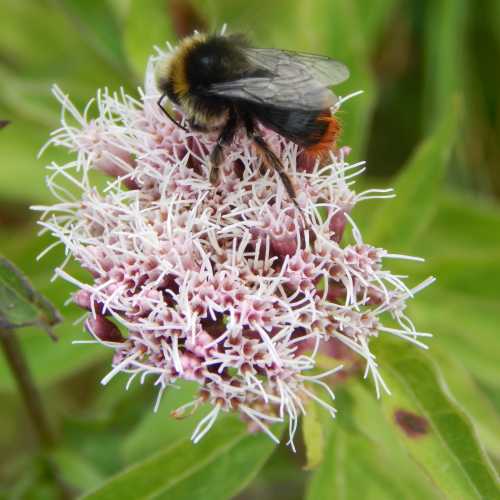All About The Bumble Bee
The bumble bee has long been one of my favourite insects. They are charming, industrious, and a friend to gardeners. When I was a small child, I thought they looked cute and cuddly too, so much so that I somewhat clumsily tried to handle one. Unfortunately, I had no idea how to approach such a creature, and at that stage, I didn’t know they could sting!
Well of course, I was stung! As tolerant and docile as bumble bees are, they have their limits, and being handled by a clumsy (if well-meaning) child, was obviously beyond that limit!
I recall crying my eyes out, because my sister told me the bumble bee would now die, because it had stung me, and this would cause the body to be ripped apart! Years later, of course, I know that bumble bees do not die if they sting you.
That said, stinging by bumble bees is not that common, since they are not very aggressive. A child is far more likely to be hurt through
falling over. The same goes for adults: put it this way,
I’ve been bumped 3 times in my car, but for all my years of observation and activity with bees, I have only been stung once!
For
many of us, these beautiful little creatures hold a special place in our
hearts. Who could imagine a summer without them, buzzing gently from
flower to flower? I don't know about you, but I can spend hours watching them on the lavenders -
like this one below - Bombus terrestris (buff-tailed bumble bee).
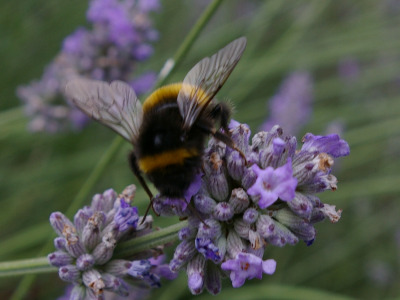 Buff-tailed bumble bee - Bombus terrestris.
Buff-tailed bumble bee - Bombus terrestris.
What’s the buzz about bumble bees?
The genus Bombus and to the family Apidae. There are social as well as
cuckoo bumble bees
(social parasites). Cuckoo species are regarded as parasites, whereby
the female cuckoo kills the host queen and takes over the nest –
although some research has found cuckoos living alongside their host,
with both rearing offspring.
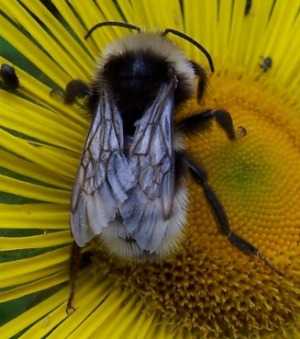 Barbut's cuckoo bee - Bombus barbutellus.
Barbut's cuckoo bee - Bombus barbutellus.Bumble bees have their fair share of natural predators and enemies, but without a doubt, human activity is the biggest cause of problems faced by this important little pollinator.
Bumble bees vary in their choice of nest site. Some prefer to nest on tussocky grass clumps, others will choose an abandoned rodent hole, or a crevice in a wall. Some will even nest in the compost heap, or in a bird house. Early in the season, you may witness large bumble bees bumping up against the window of your home as they seek a nest site.
We're still learning about plant pollination and bumble bees!
Although we have much to learn about bee pollination, we do know that bumble bees are perfectly designed for this task! As their
furry, fat bodies enter flowers, much pollen is caught on their fluffy
coats, and so is easily transferred from the male anthers of a flower,
on to the female part of a flower, known as the stigma.
Any remaining pollen on their furry coats can be combed from their bodies, formed into a little ball, and stored in the bee’s pollen baskets – or corbiculae, to be carried back to the nest.
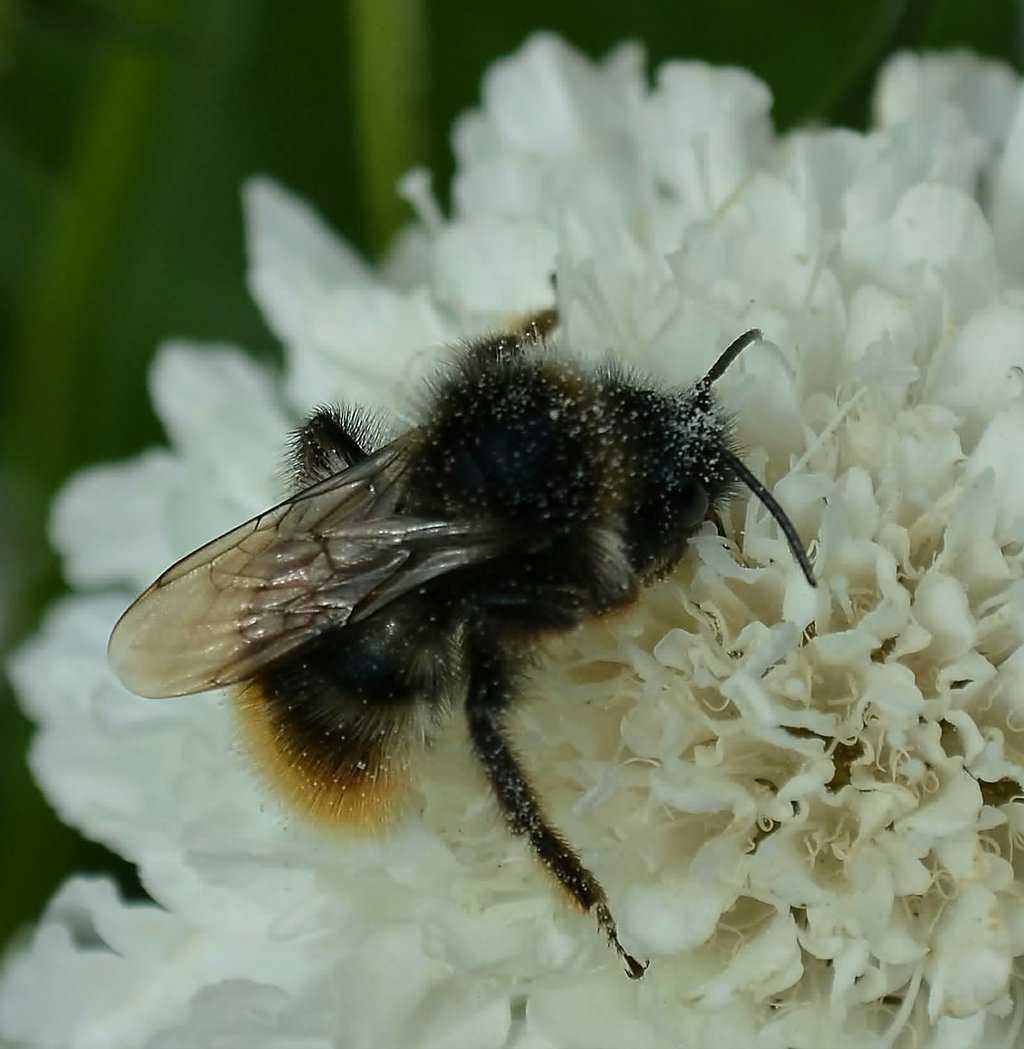 Red-shanked carder bee - Bombus ruderarius on Scabiosa.
Red-shanked carder bee - Bombus ruderarius on Scabiosa.Different species have different tongue lengths too, resulting in varied foraging preferences. All this means that some species are better adapted to pollinate certain plants than others.
Add this to the fact that they can ‘buzz pollinate’, and you begin to see why this insect is so important to both the environment and humans.
Without a doubt, they perform an important service as pollinators in our gardens, and increasingly in large scale food crop production such as tomatoes, soft fruits (like strawberries, cranberries), as well as pollinating beans, peas, wildflowers and many other types of plant life.
Being furry, and having evolved in the Himalayas, the bumble bee is also well adapted to comparatively cooler weather conditions. They generate heat by vibrating their flight muscles, hence performing a ‘warm up’ before venturing out during the cooler seasons, even when other insects are still in hibernation.
Read more about the bumble bee lifecycle.
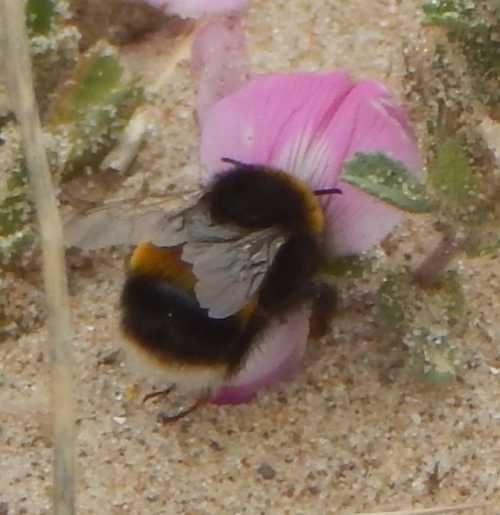 Buff-tailed bumble bee on restharrow.
Buff-tailed bumble bee on restharrow.Some species provide a late season plant pollination service. Bombus pascuorum, the Common Carder bumble bee (as seen at the top of the page), may even be around as late as November.
In order for these sturdy little pollinators to thrive though, they need a good supply of nectar and pollen rich foods. Of course, we can all do our bit to help them during the cold winter months, when they are especially vulnerable, by providing year round flowering plants. You can certainly help bees generally by ensuring you have plenty of bee plants in your garden.
Bumble bees endangered or extinct in the UK and America
Worldwide there are about 250 known species. Unfortunately, relatively little attention has been paid to these most vital pollinators. We do know, however, that in the West particularly, worrying declines in populations are now being noticed.
Bumble bee decline in North America
North America has 50 native species, of which 4 species that were formerly common, have hit catastrophic declines, with two possibly on the brink of extinction. These 4 species are:
- Bombus affinis
- Bombus terricola
- Bombus franlini
-Bombus occidentalis
Worrying declines have been noted in a large number of other species, including:
- Bombus pensylvanicus
- Bombus fervidus
- Bombus sonorus
- Bombus californicus
Read about Bumble bees of North America.
Bumble bee decline in the UK
At the time of writing (2010) in the UK, 3 species have become extinct. These are:
- Bombus subterraneous
- Bombus pomorum
- Bombus cullumanus
Of the remaining 24 species, 2 are critically endangered, and 10 are in very serious decline, which includes 6 Biodiversity Action Plan species.
Read more about British Bumble bees.
Why should we be concerned about bumble bee decline?
Apart from the fact that they are beautiful creatures, all bees are important - here are 10 reasons why bees matter.
In China, in valleys where bumble bees used to pollinate groves of pears, they have been driven out by pesticides. Efforts to bring in honey bees for pollination were not successful since beekeepers were reluctant to risk their colonies. Unfortunately, it does not necessarily follow that one bee species can replace another in terms of the pollination service provided! Humans are now going up into the pear trees, to pollinate them by hand!
We now know that not all bees (or insects) pollinate all plants effectively - even if they take their nectar! We cannot simply take it for granted that if one species dies out, something else will 'do its job' instead.
Problems for bumble bees
- Modern agricultural practices are a major problem. These practices
have resulted in far fewer meadows and wild flower strips.
- The impact
of pesticides on bees is of tremendous concern too – particularly
systemic and neonicotinoid pesticides.
- As stated, bumble bees vary in their choice of nest site. Some bumble bee species like to make their nests at the base of
hedgerows. Many hedgerows feature plants favoured by many types of
bees, and not just bumble bees: brambles, hawthorn, honey suckle to name
only a few. With the grubbing up of hedgerows, this has resulted in not
only loss of foraging opportunities for bees, but also available nest
sites.
Of course, there is much we can all do to help all bees, including the bumble bee.
10 Simple Things YOU Can Do To Save The Bees.
If you found this page helpful or interesting, I'd really be grateful if you would share it with others - if not this page, perhaps another, such as Gardening For Bees.
Thank you so much :) .
